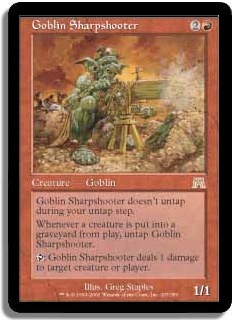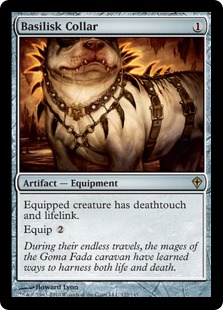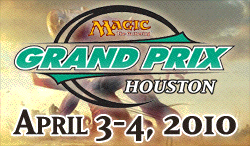First, a well-deserved hearty congratulations has to go out to not just Pete Hoefling and crew, but all of you; the Indianapolis $5k was a wild success, outpulling a Grand Prix in attendance the same weekend, a feat that probably has never happened before. Why a congratulations to all of you, when, like me, many of you probably didn’t attend? Well, you’re giving your support to StarCityGames by reading this site and buying from this site, and it makes events like this possible.
I for one wished that I could be there. I’d gotten to a point in Standard that has brought me around to the happy feelings that I had had previous to the release of Worldwake. We’re, at least for now, back to the world of Ball Lightning.
Creatures (22)
- 4 Ball Lightning
- 4 Hell's Thunder
- 4 Hellspark Elemental
- 4 Goblin Guide
- 2 Obsidian Fireheart
- 4 Plated Geopede
Lands (25)
Spells (13)

This is my old, pre-Worldwake Sligh deck that I’ve already written about. I loved this deck. It kept performing for me, and I’d put it into queues as a money-maker, and it was exciting to see it Top 8 at the Dallas Open. A real key to the deck, in my opinion, had been its ability to become a de facto “control” deck so that decks like UWR-Control would find itself fighting the wrong fight against it, and nearly always fail.
But I was struggling once Worldwake came out; the new decks were just able to outperform the deck. It wasn’t just that the other decks were all upgraded. It was also that there were real problems that suddenly needed overcoming that weren’t the case in the past. With the result from San Diego in, the queues were quickly filling up with Mythic and Boss Naya decks, and Wescoe’s Tricked-Out WW was also on hand. My poor little deck was just getting to the point of being outclassed.
What was there to do? I hadn’t done any drafts yet, so I didn’t have any of the new cards, and even after I began drafting, I didn’t start with the WWW-queues until late in the game. Before the Pro Tour, I thought that Cunning Sparkmage could go a long way, in the sideboard, but I wasn’t really sure of its raw power. After the Tour, I’d had that power confirmed for me, along with some more food for thought.
The Cunning Sparkmage/Basilisk Collar combo has been called “cute” recently, but really, it isn’t that the combo is necessarily so “cute” so much that it can be utterly devastating against the right opponents. Even if it is partly broken up, either side of the combo can still be quite strong; that Goblin Guide on defense can do a great job of holding off a Knight of Reliquary if it is wearing a Basilisk Collar, and that Cunning Sparkmage can gang up with burn to kill the larger creatures all the more easily.
Previous to this, I’d largely used Chandra Nalaar as my go-to girl for handling the big critters, and it was mostly very good at this job, though it certainly had some limitations to its applications. The Collar/Sparkmage combo could take up this role quite well, but it had the unfortunate side effect of eating up several more sideboard slots.
This brings up, though, the aside of the Red/Red mirror match. Of all of the opponents that I might draw in queues, typically, I’d love to pull the near mirror. A part of it is that I trusted my own skill over that of my opponents in the matchup. But another part of it was that most opponents would have an approach to the mirror that I though was fundamentally wrong: they’d lean on Dragon’s Claw.
The whole point of Dragon’s Claw is to make sure that your life total stays higher than your opponent so that they can’t kill you, and since you are both mono-Red, you can expect that even a single Dragon’s Claw is going to gain you a lot of life, let alone the value you can get out of more than one. In practice, though, I always found this path to be lacking.
You can “gain” life by making your opponent’s burn be forced after your critters (or Planeswalkers). You can “gain” life by making sure that their critters don’t connect with you. What would nearly always happen is that the Claw would sit their, gaining life for an opponent, while you’d slowly pull ahead on the board, and they’d eventually succumb to it. Sure, sometimes they’d win, but I had such a ridiculous win percent in the mirror (a smidge above 80%), I generally felt incredibly comfortable with the mirror, only worrying if my opponent didn’t cast Dragon’s Claw (since this generally meant they drew more business).
Here’s my old version of Sully Sligh, sideboarded for the mirror:
4 Plated Geopede
4 Hellspark Elemental
4 Hell’s Thunder
4 Obsidian Fireheart
3 Siege-gang Commander
4 Burst Lightning
4 Lightning Bolt
3 Punishing Fire
2 Volcanic Fallout
3 Chandra Nalaar
4 Arid Mesa
4 Scalding Tarn
4 Teetering Peaks
2 Valakut, The Molten Pinnacle
11 Mountain
This plan’s big weakness was if an opponent got a heavy Hell’s Thunder draw paired with Quenchable Fire. The damage that couldn’t be stopped, particularly from the heavy Quenchable Fire draws, could never be recovered from.
Then, a huge hole in this plan came out of Worldwake: Searing Blaze.
With Searing Blaze in the mix, it was just inevitable that you’d have incidental loss of life from a Red opponent as they fought your board. Then, that fire they’d been holding would just naturally turn towards your face. The gig was up.
Except, of course, Basilisk Collar can ride to the rescue.
In many ways, then, the Basilisk Collar can act like a super-charged version of what you’d want to be doing in the Red mirror with Dragon’s Claw: you’d be incidentally gaining life throughout the match. In a bona fide race, even a smidge of life gain could be huge, but usually it was costing you a card. With things like Cunning Sparkmage, or first strike from Plated Geopede, a Collar wasn’t just a “dead” card on the board — it was really doing something. What was better, with the current rules of Magic, was that a Siege-gang Commander or Cunning Sparkmage that was equipped would still gain you the life you needed it to if it was dead.
With the double-duty of Sparkmage/Collar firmly established, I could get behind placing them both in the board. The real question for me was what to do about the main deck.
The question largely revolved around Searing Blaze. A lot of people are (foolishly) calling this card a two-for-one, or even “like” a two-for-one. Incidental damage is just that. It isn’t a free card. Make no mistake, if you cast a Lava Spike you are getting zero-for-one. If you cast a Lightning Bolt at someone’s head, you are getting zero-for-one. The thing is, sometimes this is what you want to be doing.
The problem with Searing Blaze in the old Red deck, if it could have had it, is that it really didn’t want it. A matchup like Jund was still a good matchup. A matchup like Vampires is still a bad matchup. Searing Blaze wasn’t going to change any of that, and it would have the added problem of making some matchups (like Turbo-Fog) very problematic.
Generally speaking, a Red deck wants unconditional damage. It doesn’t want to have to hope that it can get the damage. In the world of Extended, Searing Blaze is very nearly unconditional damage. But in the world of Yesterday’s Standard, Searing Blaze is so conditional as to be scarily so, except in matchups that it doesn’t help.
And so, I was definitely not too particularly excited about Searing Blaze for the kind of Red deck I wanted to be playing. But then, as the new metagame emerged, it became clear that there was a home for Searing Blaze. While the Chapin UW deck wasn’t going to be very hospitable to it, the rest of the metagame looked like it would be. With this in mind, then, I had to come to terms with the fact that Searing Blaze was going to be a card I could expect to be successfully casting. The question then becomes, what of Quenchable Fire, a card which does nothing other than reduce the life total of the opponent, and, for many opponents, by a lot. Quenchable Fire is particularly good against a deck like Jund, because it is simply a straight-up six damage. As Jund began to emerge as the dominant deck in the post-PT Standard world, I had my deck.
Creatures (20)
Lands (25)
Spells (15)

I’m still not fully happy with the sideboard. I used to be able to have quick pull aparts of the deck where I felt confident of how to set it up against basically any deck that isn’t Vampires. I’m still not there with this build.
A part of it is probably the Quenchable Fire. It can do a lot of damage, but a part of me still somewhat prefers a card like Elemental Appeal, even if it can be taken out. Kicking an Elemental Appeal was something that seemed to happen a lot for this deck after sideboard, so even if it was damage that was more vulnerable to being stopped, the possibility of that kicked Appeal seemed to make it so worth it. Quenchable Fire, on the other hand, sometimes leaves me feeling overly exposed, like somehow something is going to go wrong. Probably, though, that is just some form of jitters.
You’ll notice that there is no “direct” answer to Kor Firewalker. A part of this is because of Basilisk Collar. If you are gaining life as well, a Firewalker really can’t race the same way. At the same point, if they’re hanging back, you often don’t mind going for a waiting game, because this gives you more time to get to a Valakut trigger, a Sparkmage, a Siege-gang, or a Fireheart. Any of these will make a Firewalker have trouble, and an opponent getting down multiple Firewalkers is deeply unlikely, partly because most decks can’t play Firewalker and partly because if they do, they really do need to draw two to make you care too much.
If we look at the top eight from this last weekend’s big events we have this:
Leong Red — Winner GP Kuala Lumpur
Boros Deck Wins — 1 Top 8
Jund — Winner Indy Open, 10 Top 8s
Spread ‘Em — 1 Top 8
Naya — 1 Top 8
Mythic — 1 Top 8
Boss Naya — 1 Top 8
If you’re curious, that is four – count ‘em – four Kor Firewalker out of 1200 cards.
Leong Red is the name I’m just giving to the Blightning Red deck piloted by Ding Yuan Leong at Grand Prix: Kuala Lumpur. His Black mana certainly gives him a bevy of answers to a Firewalker, should one show up. Here’s his solution to the same problems I was trying to answer:
Creatures (16)
Lands (24)
Spells (20)
Sideboard

His deck takes a common shell from Mono-Red, and cuts out the Teetering Peaks for Lavaclaw Reaches. Dragonskull Summit takes up a few Mountain slots, and he cuts Plated Geopede (always a hard worker) for Blightning. It’s a very simple switch, and while it cuts out some of his fast critters, it does make his whole deck into a deck of immediate damage. Essentially, other than that, his main deck conformed to Tomoharu Saito’s build (at 13th place) nearly straight up (though Saito broke with current wisdom by cutting the Quenchable Fire in favor of a full package of Burst Lightning and a 25th land). Saito chose to answer Firewalker in a very different way than Leong did — Saito used Unstable Footing and splashed Journey to Nowhere in his board.
You’ll notice he has six rock-solid answers to a Firewalker. Those Deathmark can work extra duty against the Big Critter Green decks like Mythic, or help wipe up an Elves player.
I’m pretty sure what every card in his deck is doing except Goblin Ruinblaster. It used to be that I’d see Ruinblasters as a reasonable solution to Jund decks, but these days, with the sheer mana that those decks are packing, I just don’t know that Ruinblaster does much of anything to them. On the other hand, it might just be a good solution to a deck like Grixis, U/W Control, or other decks… An examination of his boarded games versus Jund doesn’t give much in the way of clues as to what he boarded in or out, but I wouldn’t be surprised if Quenchable Fire came in; he certainly had some in his game twos.
Right now is likely the best short window you’ll have for a deck like Red; it won’t take much time at all for Firewalker-based decks to re-emerge. Jund will make concessions specific to Red, a deck that is often Jund’s Achilles Heel, but that it can safely ignore because of its lack of general popularity. That moment will end soon…
I’m still not 100% sure where I’ll go with the archetype. I think there are still some other ways to go. Maybe the deck really just wants those Quenchable Fires, but maybe they can go elsewhere. Saito cut Quenchable Fire to great success, after all… Maybe I can go the way of Leong and cut Plated Geopede (though this idea pains me). I do know that there are a lot of directions left, though.
Until next week…
Special Mini-Bonus, ONE:
As I explored the possibilities of Cunning Sparkmage and Basilisk Collar, I was lead down the path to one of my favorite archetypes of old: Ponza.
Here is my current list. It is still incredibly rough, and I’m happy to hear anyone’s ideas:
Creatures (14)
- 4 Siege-Gang Commander
- 1 Magma Phoenix
- 4 Goblin Ruinblaster
- 3 Cunning Sparkmage
- 2 Kazuul, Tyrant of the Cliffs
Planeswalkers (2)
Lands (25)
Spells (19)

I’m still trying a lot of things with this deck. Surprisingly, I’ve been coming to find that Roiling Terrain can be an incredible source of damage when it is helping out Ruinblaster or other such cards. Many games can swing wildly out of an opponent’s control very quickly because of the mana suppression that the deck is capable of.
I’m still not sure about many cards, too. Take a card like Magma Phoenix; Magma Phoenix is absolutely insane when you have a Basilisk Collar on it and it goes POP! At the same time, it might just be too cute. I’m still trying to work that out…
This deck is really just an experiment. I’m not sure if it will play out, but I’ve always believed it is a good idea to experiment with deckbuilding, just so long as you are willing to set aside your pet deck when it comes time to play in the tournament.
Special Mini-Bonus, TWO:
So, while I don’t think there is a great home in Legacy for this combo, it is so cute, it takes me back to my Single Card Strategies column:


Yeah. Pop, Bang, Wow!
Goblins doesn’t appear to have time to do things like this in Legacy, but it’s still fun to think about…

